The iPhone 5 Display: Thoroughly Analyzed
by Chris Heinonen on September 27, 2012 12:00 AM ESTWhen Apple rolled out the iPhone 5, they announced that it had a full sRGB gamut, which the new iPad almost achieves and would be a substantial improvement over the 4 and 4S displays. The slight increase in screen resolution and size means we are looking at a new panel than the previous generations used as well, with the new panel being speced at 800:1 contrast ratio and 500 nits of brightness. I don’t have a 4S to test, but used my iPhone 4 that was bought on launch day and has been in use since then for comparison. Numbers were run using CalMAN 5 software, and a SpectraCal C6 colorimeter that was profiled from an i1Pro spectrometer. All readings are the average of three measurements from the C6, except for very dark readings where ten measurements were taken for more accuracy.
For comparing the minimum black and white levels in the iPhone 4 and 5, I set the brightness to the minimum level where I could get a reading from a black screen. At the minimum value I couldn’t get any reading, which indicates that it’s below the 0.001 threshhold that the C6 is capable of reading. Both phones had a minimum black level reading of 0.006 nits, but the iPhone 4 had a white level of 5.669 nits compared to the iPhone 5 and its reading of 8.303 nits. This gives us contrast ratios of 1008:1 for the iPhone 4 and 1313:1 for the iPhone 5. Both are ahead of the specified numbers, but the iPhone 5 is clearly better here.
At maximum brightness, the iPhone 4 has a maximum white output of 390 nits, and the iPhone 5 clearly trumps that with 562 nits. The backlight of the iPhone 4 could have become slightly dimmer over time, but using LEDs it really should not have faded much. Black levels for the phones are 0.355 for the iPhone 4 and 0.412 for the iPhone 5. This gives us contrast ratios of 1097:1 for the iPhone 4 and 1364:1 for the iPhone 5. Clearly contrast levels have been improved here, despite the move to a larger screen that sometimes can affect them.
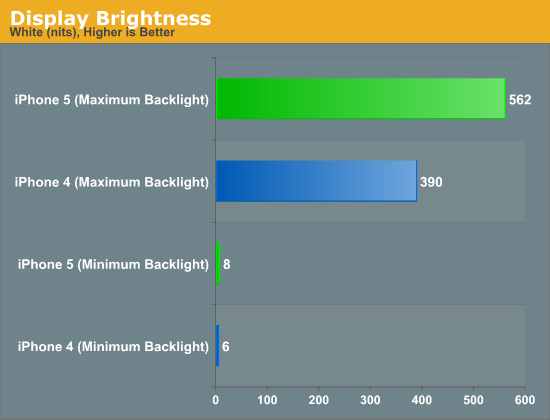

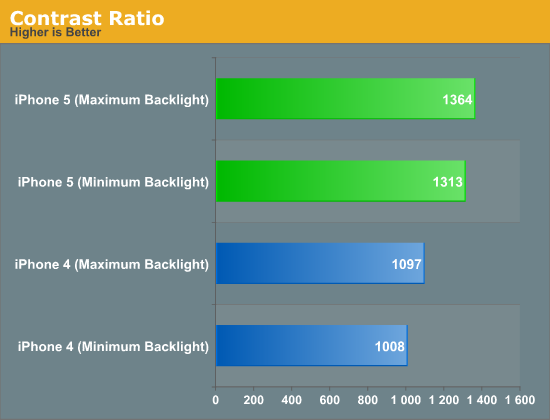
Looking at the grayscale, the iPhone 4 puts out an average dE2000 of almost 10 across the spectrum. The grayscale has a very noticeable blue shift that can be seen in the numbers, and a CCT that is close to 10000K and not the 6500K that is the sRGB standard. The gamma also shows a clear spike at the bottom when we target the sRGB gamma curve. If we target a gamma of 2.2 that spike goes away, as the sRGB gamma is linear at the bottom end. Overall the grayscale of the iPhone 4 would be rated as very poor if it was a desktop display or a television.
Looking at the iPhone 5, we see a totally different story. There is still a lack of red in the grayscale, but it’s much lower and the average dE2000 is a very respectable 3.1 across the spectrum. The gamma is again targeting 2.2 instead of sRGB which you can notice at the bottom end, but other than a couple outlier numbers at 30 and 35% stimulus, we have a grayscale that is almost entirely below the visible error line on the chart.
If I change the Gamma target to 2.2 from sRGB, you can see that the line is much flatter across the spectrum and that bump at 5% is eliminated. Since Apple uses 2.2 as the default target gamma on their computers and not the sRGB standard, I'm not too surprised to see that their phone would also target 2.2 as well.
sRGB Gamma Target
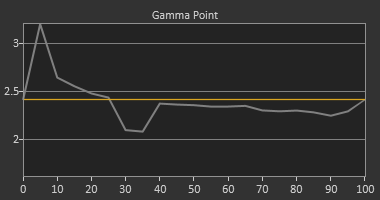
2.2 Gamma Target
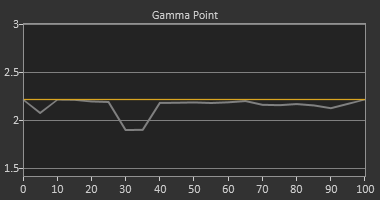
Overall the grayscale performance of the iPhone 5 is outstanding, and a world ahead of the iPhone 4 in performance.
Moving onto the color gamut, on the iPhone 4 using the CIE 1976 uv chart, we see that we clearly lack full saturation in Red, Green, and Blue in the color gamut, which leads to the secondaries also being under-saturated. Our dE2000 numbers are low for green and red, but blue is over 20 and pushes our average dE2000 over 11. This gives us errors that are clearly visible in normal use and means that many colors that fall inside of the sRGB gamut will not be rendered correctly as we can’t display the full area.
In contrast to this, the iPhone 5 covers almost the entire gamut. Red, Green, and Blue all have dE2000 values of 2.6 or less, and the average dE2000 value is 2.2, for a fantastic result. Unlike the charts for the iPhone 4 where not all of the data was visible, here we just see very small errors across the spectrum, with no individual dE component being higher than 8.
This improvement is very easy to notice on the iPhone 5 even without running numbers. Colors like the yellow in the eBay app icon are much more vivid and saturated than before, and blues have far more shades available than previously. The entire sRGB gamut is now available on the iPhone 5 and the result is outstanding.
Measuring how the phone handles saturations is another important step. While we know the iPhone 5 can reach the full saturations for each color, how well can it render those saturations that are less than 100%? Looking at the iPhone 4 quickly, we see that with its under-saturated gamut, we have very high dE2000 numbers across the board. Even lower saturations are way off the target and have high numbers. In the end this is better than those being accurate, as then anything beyond what the iPhone could display would be rendered identically so 60% blue and 100% blue would look the same, instead of both having errors that make them distinct to the eye. Of course this doesn’t excuse having an error over 10 across the whole spectrum, but that’s the choice that was made with the screens at the time.
Now looking at the iPhone 5, our numbers are even better than on the straight gamut charts. The average dE2000 drops below 2, and no single reading extends beyond 3 except for white. Across the whole spectrum of colors on the iPhone 5 you can expect accurate, well saturated colors that will look as accurate as they would on a reasonably calibrated desktop IPS display. I would be quite happy if desktop monitors and TVs were shipped this accurate.
Finally I now have the ability to run the Gretag Macbeth color checker chart on a phone to see how well they perform with non-primary and secondary colors. Since the iPhone 4 has such an under-saturated gamut, we would expect it to have a large error on the Gretag Macbeth chart and we are correct. The average dE2000 is over 8, and many of the numbers are off the charts. The only color without a visible error (below the yellow line) is black, and that really would be awful if black had a visible error. Overall the performance here is pretty mediocre, though somewhat in line with computer monitors as they are shipped to consumers.
With the iPhone 5, we see an average dE2000 of only 2.09, which would make it the best LCD monitor I would have reviewed at AnandTech to this point (in terms of out-of-the-box performance). Only a couple shades of orange creep above the green error line, and nothing moves above the yellow line that would make it clearly visible to a user. Every color point at least comes close to hitting its target, and there are no errors that are excessive or that you will notice even during color critical use.
Wrapping up, the iPhone 5 display is a quantum leap better than the display on the iPhone 4. Contrast levels and light output have both been increased, and color performance is astonishing. The full sRGB gamut is present here, and color errors are remarkably low even for a high end desktop display. While many were hoping for a move to OLED or some other screen innovation, this really is a huge step up that is very easy to quantify. To put this in perspective, in the past few years I've reviewed probably 30-40 different displays, from PC monitors to TVs to projectors. Not a single one, out of the box, can put up the Gretag Macbeth dE numbers that the iPhone can, and perhaps one projector (which listed for $20,000) can approach the grayscale and color accuracy out of the box.
Apple obviously has very high control over what parts they use and what comes off their assembly lines. I don't know if they are having the displays individually adjusted after they are assembled, or if the quality control is very strict, or if I just got a remarkably lucky sample. I do know that if TV and PC Monitor vendors were able to provide displays that looked like this out of the box, professional calibrators would lose a good amount of business. The new panel in the iPhone 5 is simply remarkable in quality and if it were a PC monitor, I'd give it a Gold Award on the basis of its performance.


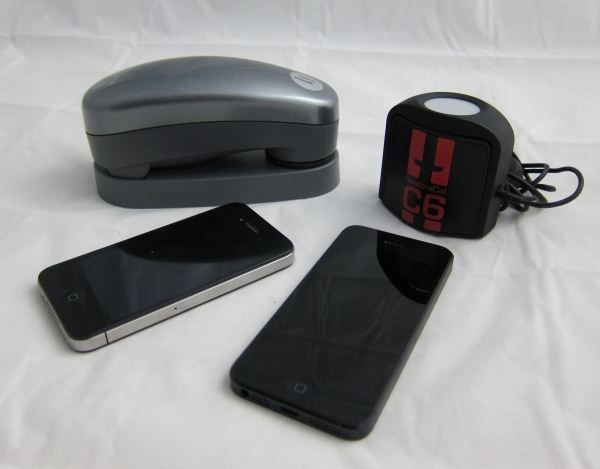
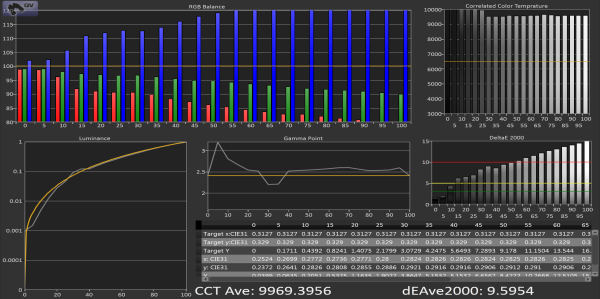





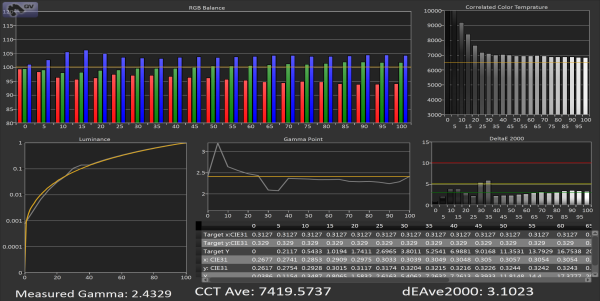





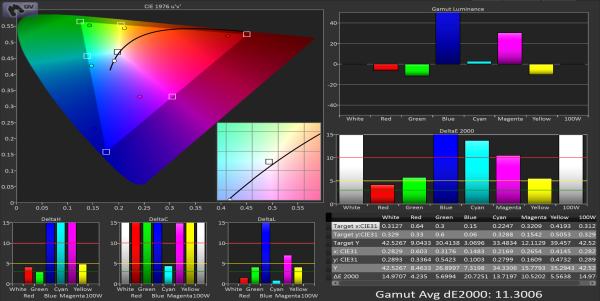



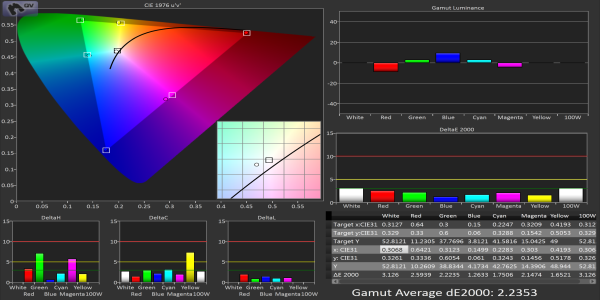


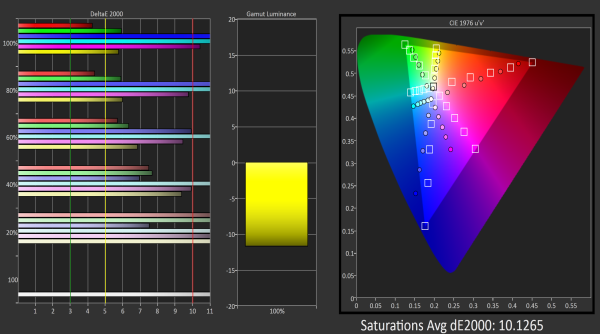






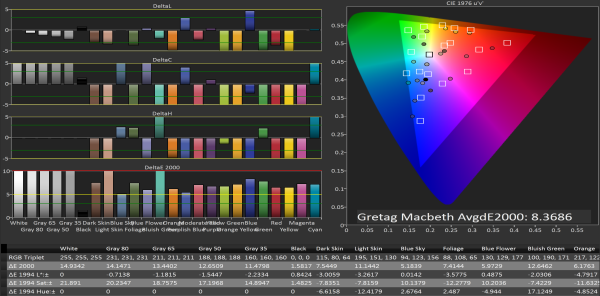





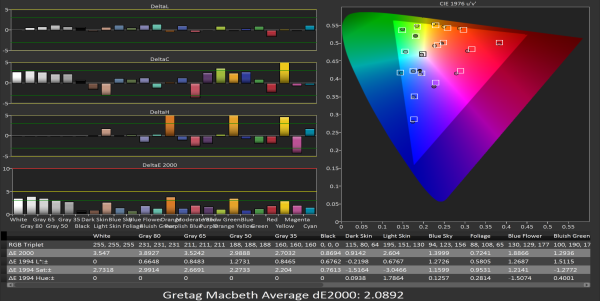













100 Comments
View All Comments
cheinonen - Thursday, September 27, 2012 - link
Brian does the majority of the smartphone reviews, and the only ones I have on hand are what my wife or I own, which means an iPhone 4 and an iPhone 5. If I can manage to get a loaner S III from someone, I'll run the same tests on it with the same patterns.bill4 - Thursday, September 27, 2012 - link
who cares, if i look at my gs3 versus a friends iphone screen, it's obvious the gs3 wins hands down. Phone displays should be built around how they look to people's eyes that use them, and not some lab geek calibration testing, and GS3 wins.Especially given how terrible the iPhone LCD looks because it does not have true blacks like OLED, only grays.
appears to me apple is chasing irrelevant metrics, and the ultra apple biased media such as anand is only too happy to oblige.
Not saying it's an irrelevant metric, but remember when Android phones were all 800X480 and had a higher PPI than iphone 640X360 at the time? and not one single site EVER mentioned it (certainly Anandtech never did)? Then Apple comes out with the Retina display and has an edge in the PPI spec for a while, and suddenly sites like Anandtech act like PPI is the most important thing in display when they never gave a crap about it until Apple had an edge? Hell even now that Android phones have higher res again by and large, you see less talk about PPI. So the less Apple wins a spec, the less Anand talks about it, and vice versa.
Yeah, same idea.
doobydoo - Thursday, September 27, 2012 - link
You don't get to just say 'it's obvious the gs3 wins hands down', that means nothing.Any fanboy can say precisely the reverse. That is why independent and objective review sites like this exist.
I'm also pretty sure every single site which compared phones pointed out the higher resolution at the time of Android phones.
For your info - Apple still has the edge in PPI terms over most phones. The Samsung Galaxy S3 isn't even comparable because it doesn't even use full pixels - it has a PenTile display which actually has fewer sub pixels than iPhone 5's smaller screen.
The reason the conversation moved to PPI was because phones reached a point (through Apple) where an increase in resolution wouldn't affect what the consumer would see, so there is no benefit to increasing the resolution past that point. You can only measure that with PPI because resolution doesn't take into account screen size.
bill4 - Thursday, September 27, 2012 - link
No they didn't. No site ever even mentioned the word "PPI" til Apple had the advantage. EVER. LOL.And LOL, I can tell you're a fanboy it just oozes in your post. The whole "your eyes cant see beyond retina anyway" was proved to be marketing BS by many technical websites. Stop believing everything your great king Apple hands down to you from on high.
sub pixels are not pixels btw. But I must say the whole pentile/non pentile thing is super overblown anyway, mostly because Apple doesn't use pentile so tech sites attack it. If Apple was using pentile displays the tech sites would not mention it's deficiencies.
Just pick up a GS3, the screen is spectacular, the end. Mainly, the fundamental edge OLED has is true blacks and contrast, which obviously is much better than the iPhone 5 in contrast ratio.
See, we can always pick certain specs where each side wins. So what?
Anyways, the reasons I would never buy an iPhone are the garbage stale fisher price OS, the small screen, and Apple's locked down nature/no file browsing/itunes bullshit.
It amazes me Apple has 100 billion in the bank and their OS looks like Fisher Price designed it at this point. Yeah, it was cutting edge, 5 years ago...
Anyways I own a lot of Apple stock, I hate the company, but I can also see online they have millions of fanboys that you that irrationally buy their products no matter how poor they are. But lately the stock has been falling (dont worry, I already have a huge profit lol), and the iPhone 5 sales of 5 million initially were considered disappointing. Just to show you and Anandtech that Apple is faltering despite your best efforts.
Trypticon808 - Thursday, September 27, 2012 - link
Do you even lift?tuxRoller - Thursday, September 27, 2012 - link
While I'm not sure I agree with rest of your post I do think you are right about the PPI issue. Basically with each major Apple launch they tout a new feature. Said feature is well known to "real" geeks, but is new to technorati so it gets bandied about constantly as reasons why the product they've chosen to speak their identity is superior to another. Some examples are: unibody, back-illuminated sensor, multi-touch, "retina"/ppi, etc.Now we can expect sRGB gamut to be a new one to add to the list.
Of course, prior to this announcement we didn't hear that the iphone screen didn't cover the gamut. Nor, prior to the iphone 4 did we hear that the previous iphone didn't carry BSI sensors.
So, what will be the next must have feature?
BTW, none of these things are bad. It's great they are encouraging people to demand more from their products. I simply wish they would do so between versions.
wicktron - Thursday, September 27, 2012 - link
First, what's with Android users proclaiming that any Apple user is some sort of zealot that follows some sort of religion? What makes Android users any different? I really don't understand fanboyism.Second, if these metrics are so irrelevant, why are so many Android fans so enamored when an Android device gets X-inches larger, or has Y-GHz processor and Z-GBs of RAM?
Metrics and standardized, unbiased testing provide a level of quantitative measure that can't be done based solely on empirical and qualitative analysis.
You and I can disagree on what's better to us based on personal opinion and preference, whereas hard numbers cannot be disputed.
--
With that said, here's my thought on a SGS3 screen: It's nice due to the fact that colors are over saturated. The downside is that images look completely unnatural because the colors and contrast just scream at you.
Personally, I'd much rather have pinpoint accurate colors and razor sharp text. I can see and share photos the way they were meant to be portrayed.
TechDenzo - Thursday, September 27, 2012 - link
Completely agree with this post. This is logic.Also I can say as a previous owner of a SGS2 (good phone) the screen was great. Resolution was terrible (800x480) but the colours were great for a Amoled.
SGS3 though is disgusting. The screen looks like its constantly draped in blue/green, which to me looks cheap and tacky, not saturated like the SGS2 screen.
This could be due to the Pentile, Im not sure, but its blatantly obvious how bad it is, and they dont even have to be side by side.
ONE X to me has a much nicer screen than SGS3.
TechDenzo - Thursday, September 27, 2012 - link
Sorry but your post doesnt make any sense.You think if Apple used Pentil matrix displays no one would say anything?
2 things:
1. Apple dont use Pentile displays.
2. I stopped reading your post after that cause I knew it would subjective rubbish.
doobydoo - Thursday, September 27, 2012 - link
'No they didn't. No site ever even mentioned the word "PPI" til Apple had the advantage. EVER. LOL.'Perhaps you should re-read what I said, specifically:
'every single site which compared phones pointed out the higher resolution at the time of Android phones'
Note that I wasn't referring to PPI. I later explained why PPI became more relevant.
The limit of human vision perception has been validated by numerous world renown eye experts, which back up the scientific basis behind Apples claims at the time.
'sub pixels are not pixels btw'
I know, I didn't say they were. A true pixel has 3 sub pixels. The PenTile display in the SG3 has 2 sub pixels per pixel, which is why the quality is lower despite them still claiming more pixels.
'If Apple was using pentile displays the tech sites would not mention it's deficiencies.'
Sorry, but they most definitely would.
'Just pick up a GS3, the screen is spectacular, the end'
I've picked up both an SG3 and an iPhone 5 - and the iPhone 5 screen looks crisper and the colours look more natural to me.
As for all your 'fisher price' rant after that, it's just uninformed nonsense from an angry Android fanboy.